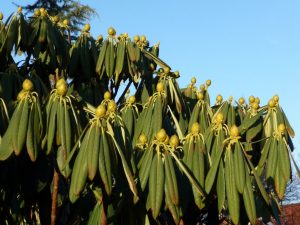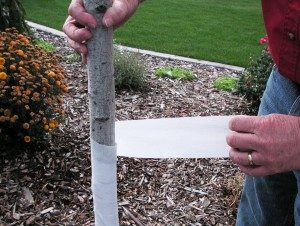
Colored branches of redtwig dogwood
Many landscape plants die during the winter but there are steps you can take to lower the mortality rate. More plants die from root rot (our clay soils hold water during the winter and early spring) than from drought. It’s too late now to improve the drainage of your beds but when spring comes, I suggest adding some Turface and working it into the top inches of soil. It will eventually work its way down further.

Dessicated Rhododendron leaves-panoramio.com
All plants expel water into the air through their leaves. Broadleaf evergreens such as azaleas and rhododendrons become dessicated (droopiness and scorched edges are the best indicators) much more easily than coniferous evergreens. Buy an anti-dessicant (Wilt-Pruf, Vapor Guard, and Transfilm are the most common). The best time to spray the leaves is late fall. Since that window has closed, wait for a day when the temperature is above freezing and there is no threat of rain or frost within 24 hours. Reapply in February.

Conifers in bondage

Pennisetum and Spiraea seedheads in my garden
I often see coniferous evergreens wrapped in burlap to protect them from salt spray. This has to be one of my pet peeves. The reason for planting evergreens is seeing green in the gray months. If you can’t see them, what’s the point? Plant something else, like ornamental grasses, that do not suffer from salt intolerance and will be beautiful during the winter. You want to see plants that will lift your spirits.

TreeWrap-townandcountrygardens.com
Young trees often suffer from sunscald (bark splitting) when the temperature drops suddenly. TThe best preventive is a breathable tree wrap, such as burlap, fabric, or bamboo. Wrap around the bark for the winter but be sure to remove it in Spring after temperatures rise into the fifties.

Agastache ‘Blue Fortune’ seedheads (Sam Bahr-UMD)
Did you remember to mulch perennials that were planted this year? Mulch mitigates the temperature swings that we see in the freeze/thaw cycles and thus is a help in preventing plant heaving. If you notice plants whose roots can be seen, get out your shovel if the ground isn’t frozen. If it is frozen, cover the roots with soil, mulch, straw or whatever you can find so that the roots do not dry out and replant as soon as the ground is workable.

Rose canes and hips with snow in my garden
Hopefully, you did not prune your roses unless they had long branches that would whip around in the winter winds. Even then, it is best to prune no lower than three feet so that if and when there is dieback, the canes do not die all the way back to the rootstock. Rose pruning is best done in early spring when you see leaf buds.

Fallen beech limb with snow

Sedum ‘Hab Grey’ hips covered in ice
I’m sure many of you are moaning that winter is here. Let me suggest that you embrace winter and, especially, snow. It beautifies otherwise dull landscapes and makes plants into sculptures.


0 Comments